 |
Prototype campus information system. The user wears a backpack and
headworn display, and holds a handheld display and its stylus.
|
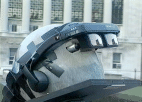 |
This dummy head was used to capture the following images through our
headworn display. A camera in the right eye socket captures what a
user wearing the display would see.
|
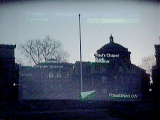 |
View shot through the see-through headworn display, showing campus
buildings with overlaid names. Labels increase in brightness as they
near the center of the display.
|
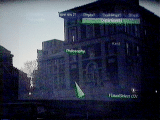 |
A view of the Philosophy Building with the "Departments" menu item
highlighted.
|
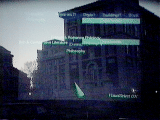 |
After the "Departments" menu item is selected, the department list for
the Philosophy Building is added to the world, arrayed about the
building. The three figures show the label animation sequence:
(a) a fraction of a second after selection...
|
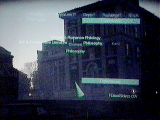 |
(b) approximately half a second later, and...
|
 |
(c) after the animation has finished
|
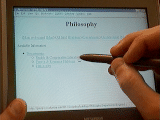 |
Selecting the "Departments" menu item causes an
automatically-generated URL to be sent to the web browser on the
handheld computer, containing the department list for the Philosophy
Building.
|
 |
Actual home page for the English and Comparative Literature
department, as selected from either the generated browser page or the
department list in the augmented world.
|
All these images show a line of debug information about
the currently received GPS data in the bottom half of the screen. The
first part gives the current location relative to a reference point on
campus, and the second part gives status information about the GPS
satellites that are currently visible, including their ID numbers.
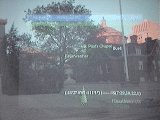 |
A view from the steps of Low Library facing to the North West of
Columbia's Campus. The user is focusing on St. Paul's Chapel,
whose label is selected accordingly. The nearby Fayerweather and Buell
buildings are also labeled.
|
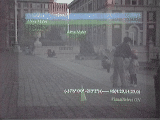 |
A view of Columbia's statue of Alma Mater seen from the western top
part of the steps in front of Low Library.
|
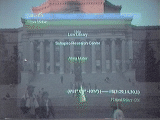 |
This image shows Low Library's front view as seen from the middle of
"campus walk", the main west-to-east pathway across the campus. Currently
selected is the statue of Alma Mater. Note that the labels lined up
above Alma Mater refer to buildings in a straight line behind Low
Library. They are drawn at the center of their respective buildings,
taking into account the correct height of and distance to their building.
|
 |
The user is turning right from the (still selected) Schermerhorn
building to take a look at St. Paul's Chapel, Buell, and
Fayerweather. Note the (slightly) different relationship of the three
latter buildings' labels as compared to the first image in this set
due to a different observer's position.
The Buell building is about
to become selected, as shown by the yellow color of its label.
|
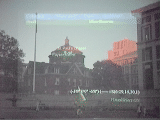 |
The user dwelled on the Buell building long enough to select it. Its
menu line has appeared underneath the toplevel menu.
|
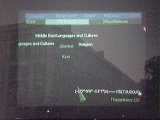 |
This image shows the Kent Building and the departments associated with
it (East Asian Languages and Cultures, Middle East
Languages and Cultures, and Religion).
|

